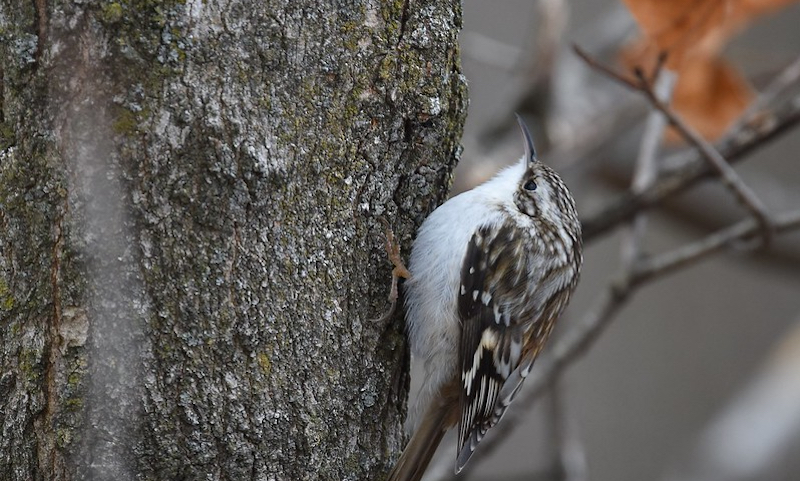BY KIERAN LINDSEY, PhD
[Thanks to Lafayette Square residents Jim and Carolyn Willmore for reporting a brown creeper sighting near the Cook Pavilion of Lafayette Park.]
On frosty mornings, Mercury is uncharacteristically slow to leave that snug thermometer bulb… and I can’t say I blame him. I’ve been in no hurry to leave my own cozy bed since Winter hit town back in early November. However, my terrier and personal trainer, Dashiell Riprock, is stubbornly insistent about our regularly scheduled morning walks, so eventually I do crawl out from my nest of quilts.
As I help Dash into his cable knit sweater, tuck my hair beneath a wool beanie, wrap my neck in layers of scarf, slide my arms into a puffy parka, and check the pockets for gloves, I’m mentally bracing for the icy slap in the face that Jack Frost will inevitably deliver when we step through the front door. Walking down the hall of this block-long building toward the exit, I have some time to think about all the creatures, human and non-human, tame and wild, who spent the night outdoors, without the benefit of blankets and central heating. That usually freezes my whiny, self-pitying thoughts in their tracks (for a little while, anyway).

All those flighty folk who come to St. Louis every year to raise kids have moved on to warmer climes but there are plenty of year-round avian neighbors, as well as old feathered friends who arrive on the cold north wind. Brown Creepers (Certhia americana), for example, leave the mature forests of southern Alaska, Canada, the Pacific Northwest, the Sierra Nevada range, the Rocky Mountains, the Great Lakes, and the upper Northeast once child-rearing season has passed, and breeze into my hometown by mid-to-late autumn. The Brown Creeper’s year-round territory used to include a larger portion of the lower 48 but as old growth forests were milled into lumber, many breeding populations were displaced; now the creeper is a seasonal visitor here in the Midwest.

For the longest time, naturalists puzzled over the Brown Creeper’s nesting strategy, or seeming lack thereof. Where, oh where, could those little nests be?
Until the late 1800s, little was known about this petite pine-cone of a bird. Creepers aren’t the easiest species to spot, especially during verdant months. Their cryptic plumage of birch, cedar, maple, and walnut browns can masquerade as the bark on which most of this bird’s life is lived, tacked in place by strong toes and sharp nails. Camouflage patterns of sun and shadow created by leafy branches only adds to the illusion.
Persistent observation finally uncovered the secret. A mated pair of Creepers will rummage over the surface of large, senior trees searching for a loose piece of bark, a turned up collar that will shield the nursery within from wind and rain (and naturalists’ prying eyes). Then, as the male sings encouragement from nearby, the female forms a secure sling of grass and other leaves, lichens, mosses, feathers, and hair, tacking her collage materials together and in place with sticky spider egg cases and insect cocoons.
Once construction and decoration are complete, she’ll slip into this wood-paneled berth for about a month to incubate a clutch of 5-6 eggs. When the chicks hatch, she and her mate share feeding duties, ducking out of sight throughout the day.
Once the year’s offspring have successfully launched, Brown Creepers are far less insistent on the privacy afforded by a secluded forest. They’ll take advantage of a much wider variety of habitats, including urban parks and suburbs, as long as there’s some sizeable timber in the neighborhood. They’re also not as reclusive, which makes them easier to observe. In some cases, seeing a Brown Creeper at this time of year is as effortless as sitting at a kitchen table with a warm cup of coffee or cocoa and watching a backyard feeder through the window. That’s because this mostly insectivorous species will supplement the seasonally scarce supply of pine borers, stinkbugs, and spiders with peanut butter, suet, and sunflower seeds.
Your little eye is also more likely to spy this bitty brown bird in winter because, with parenting duties over for the year, the adults are no longer vanishing behind tree bark every few minutes to feed the next generation. Moreover, bare branches provide less cover, making the movement of any creature passing over the surface of a tree more noticeable… and the creeper’s mode of travel is definitely eye-catching.

Clinging close to the surface and supported by a generously starched tail, a Brown Creeper will ratchet up the bole, probing the textured surface as it rises for burrowing beetle larvae and other edible grub with its slim parentheses bill, then rappel to the roots and begin another climb. It’s this iconic and conspicuous ascension on an invisible spiral staircase that offers the most reliable way to discover and accurately identifying a bird that could otherwise easily be mistaken for a dried leaf.
Back home, as my fingers and toes melt, I think about how the comforting presence of my canine companion makes a frosty walk less chilling. I think about the massive trees of Lafayette Park sheltering miniature birds, and how the birds, in turn, safeguard those towering trees from small but potentially lethal insect invaders. And in my imagination, as the creepers traverse frozen bark jackets, smooth and swift as a zipper, trees and birds alike feel a little warmer.



